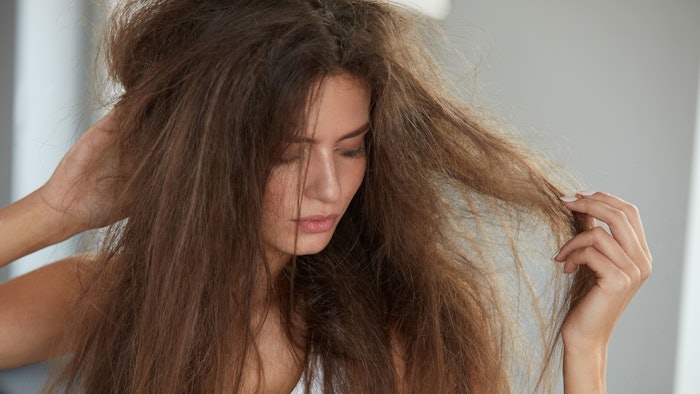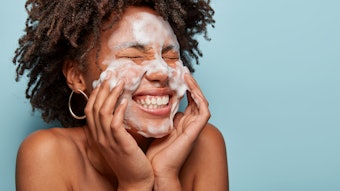
In 2007, Sinclair wrote the article “Healthy Hair: What is it?” in which he stated, “shiny hair with a smooth texture and clean-cut ends or tapered tips is generally perceived to be healthy.”1 How women feel about themselves is strongly linked to having healthy hair and achieving a desired style.2 This is important for the individual and how they present themselves to others both in a social and professional context; however, healthy hair is not always achieved.
Log in to view the full article
In 2007, Sinclair wrote the article “Healthy Hair: What is it?” in which he stated, “shiny hair with a smooth texture and clean-cut ends or tapered tips is generally perceived to be healthy.”1 How women feel about themselves is strongly linked to having healthy hair and achieving a desired style.2 This is important for the individual and how they present themselves to others both in a social and professional context; however, healthy hair is not always achieved.
This article will discuss unhealthy hair and hair that is classified as having higher levels of damage. Multiple sources of damage are typically a driving force for women to notice and feel they have no choice but to make drastic changes to their hair habits or end look. This article also will demonstrate how the appropriate choice of hair treatment products can help to reduce multi-source damage.
What is Damaged Hair?
In women who claim they have damaged hair, the most common characteristic is their perceived hair quality being a barrier to achieving the end look they desire. For example, if the goal is straight, aligned and shiny hair, the hair may instead look frizzy and dull, or lose its shine after blow drying or during the day. Or perhaps a style with defined curls is sought but instead, the curls are misaligned and the hair looks frizzy and out of control (see Figure 1, below).
Delving deeper into individual habits and practices reveals that women commonly expose their hair to more than one source of damage.3 Often, combinations of damage can intensify the damage; for example, changing the hair texture – i.e., going from straight to curly or wavy to straight – and changing the hair color. In this scenario, women are likely using chemical treatments such as color or bleaching products, and perms or relaxers, in addition to heated tools for styling.
This high level of transformation (texture, style and color) and use of treatments and tools can actually lead to levels of damage that remove the possibility for their desired end look. The solution when hair reaches this damaged state is to reduce treatments or heated tool use and/or cut the hair to remove the most damaged tips. These methods ultimately make the desired end look unachievable.
Multi-Source Damage
Let’s consider the major causes of damage and understand why multiple sources can lead to synergistically higher damage than individual sources. The published hair literature contains an abundance of information on sources of damage, including chemical treatments such as coloring, bleaching and perming; UV exposure; heated tool damage; and physical damage from combing and brushing.4 However, there is limited information on the impact of multiple sources of hair damage and the added damage of combining these sources, which is often what women experience.
An additional example to those described previously is the combination of coloring or bleaching with physical damage caused by brushing/combing. Such chemical treatments are major contributors to hair damage, as they cause oxidative damage to hair proteins and lipids. A strong correlation can be drawn between women who claim their hair is damaged and who use color and/or bleach.
However, the signs of damage that colorant users notice are driven by both underlying chemical changes, and by accompanying physical hair damage, such as broken fibers and cuticle removal, leading to split ends and more. It is the combination of these factors that will ultimately determine an individual’s perception that hair is damaged.
Chemical treatments play a significant role by increasing fiber-fiber friction and decreasing single fiber break force (see Figure 2a-b, below), especially in the wet state, which translates into more tangles and more breakage. In addition, high friction forces will cause easier removal of cuticles, leading to a higher incidence of split ends and lower shine (see Figure 2c-d, below).
Another example of this synergistic damage was published by Kao in 2004, where researchers measured lipid loss from hair that had been washed with shampoo and conditioner, and blown dry and brushed 720 times – equivalent to two years of weathering.5 This was compared with hair bleached nine times, as an equivalent to bleaching every three months over two years; and hair combining both tests – bleaching nine times with 90 washes between each cycle.
Hair exposed to both sources of damage had significantly higher lipid loss as well as amino acid changes than hair exposed to one source of damage.
P&G researchers also confirmed this synergy by sampling hair from 65 U.S. panelists and correlating their tip cuticle quality with coloring frequency (see Figure 3, below).6 Results showed that loss of cuticle leads to split ends and hair that looks and feels damaged. Consequently, a > 95% correlation was measured between cuticle quality and panelist perception of hair damage.
Heated tools, such as flat irons and curling irons when used frequently, are another common source of damage. It has been well-documented7 that heat alone can damage hair, especially above a temperature of 180°C, but it has also been found that coloring and heat can lead to additional damage when combined.
For example, a technical study was performed comparing two color cycles with 10 shampoo washes in between with two color cycles with 10 washes and flat ironing after each shampoo wash (15 passes).8 Control tests of 20 wash cycles and 20 wash cycles plus flat ironing were also included. At the end of the study, 24% more cysteic acid oxidative damage was measured, as well as 42% more protein loss and a 60% decrease in break stress for hair treated with both coloring and flat ironing versus coloring alone. The results indicated synergistically higher damage for color and flat ironing combined than either alone.
One proposed mechanism for this additional damage is that the stable peroxides in hair that form the basis for the coloring process decompose at a higher temperature to form reactive radical species (see Figure 4, below). In the described study, lipid peroxides were identified in extracts from hair after coloring but the levels of these peroxides decreased after flat ironing, supporting this hypothesis.
This same synergistic damage has also been seen with UV exposure and heat treatments9 and the mechanism is very similar. Here, UV exposure forms peroxides in hair that, with the addition of heat, create radical species. This results in the same protein and lipid degradation as observed with coloring treatments, ultimately leading to wet and dry signs of damage signals (poor feel, tangling, breakage, frizz, etc.).
Reducing Multi-Source Damage
There are two main routes to reduce multi-source damage. The first is the user changing their habits that relate to specific sources of damage; i.e., not using heat, not coloring hair or reducing UV exposure. The second is using products that can help mitigate the consequences of the sources of damage.
Changing habits: Regarding the first route, as coloring and bleaching are highly correlated with damage and well-known to damage hair proteins and lipid structures, an obvious solution is to not color or bleach the hair; or to extend time between treatments. This may be possible for some women but for others, it is not a viable solution. Coloring to remove gray hair or to avoid a dark root line are compelling reasons to color or bleach frequently.
There are optimal ways to apply coloring or bleaching treatments and in general, women visiting the salon or using expert stylist techniques typically will have less chemical damage than those applying at home. One key difference in technique is that the stylist first applies the treatment to the roots, then pulls it through the ends after ~ 20 mins whereas the typical at-home method is an all-over application.
Another change to reduce damage would be limiting the use of flat irons and curling irons – and especially decreasing their temperature when styling. Using more passes at a lower temperature causes less damage than fewer passes at a higher temperature.
Treatment products: Using products such as rinse-off and leave-in conditioners and treatments can help to mitigate hair damage from multiple sources. An optimal regimen would include gel networks and silicones or natural oils to reduce surface friction, along with ingredients that penetrate and increase hair strength. The surface lubrication prevents tangles and breakage as well as reduces cuticle damage. It also enables fiber alignment and reduces frizz, giving hair more shine and a healthier look.
Demonstrating this approach, P&G completed a long-term study where 30 women who were coloring their hair every four weeks were given a high-conditioning product regimen, including: a conditioning shampoo, rinse-out conditioner and leave-on conditioning treatment.10 After three months, participants assessed their hair damage levels. Seventy-three percent of panelists confirmed their hair seemed healthier in general and they indicated they saw improvements in signs of hair health, such as shine, reduced breakage, etc.
To confirm this perceived reduction in damage, a related study was conducted in women who used coloring products with lightening transformation (blonde shades, bleaches) and who experienced high oxidative damage. The panel consisted of 12 women having shoulder-length or longer hair who provided feedback about their perceived hair damage. They were also interviewed in detail about their habits, practices and compensating behavior.
Hair was sampled and evaluated to correlate hair quality versus personal perception. In addition, a stylist examined hair quality. Measurements included the following.
Technical measures:
1. FT-IR to assess levels of disulfide bond breakage (cysteic acid);
2. Single fiber fatigue strength (α-value, number of cycles to break 63% of fibers); and
3. Visual perception of cuticle quality at the tips using SEM. Here, 50 fibers were graded for cuticle quality based on four ratings: low damage, medium damage, high damage and no cuticle; scores were normalized on 1-100 scale, where 1 = all low damage and 100 = all no cuticle.
Stylist assessment:
1. A stylist examined hair properties, including frizz, split ends, shine and dry feel and graded hair on a 1-10 scale.
A summary of the panelists’ habits and practices is shown below in Table 1 while the technical results are provided in Table 2; stylist assessments are shown in Table 3.
Results: The underlying oxidative damage was similar for all panelists but based on other damage, the women could be divided into two distinct groups. The first group, called the “High Care” group, less frequently used heated tools such as flat irons and curling irons, and used leave-on conditioning treatments more frequently. The second group, called the “Low Care” group, used heated tools more frequently and infrequently used conditioning treatments.
The stylist assessment found the High Care group had lower frizz, lower breakage and higher shine, compared with the Low Care group. Cuticle damage at the tips was still relatively high for both groups, compared with untreated hair; however, the Low Care group had even higher cuticle damage and split ends than the High Care group.
The gathered data illustrates that multiple sources of damage can lead to dissatisfaction but the interventions of a carefully chosen regimen of products and reduced use of heated tools, even with coloring and bleaching, can keep hair looking and feeling healthy.
Hair Properties Influence on Damage
Thus far, this article has discussed sources of damage; but it has not yet considered how hair’s natural properties may influence damage from multiple sources and perceived damage. The first important hair properties to consider are its texture, curl and diameter. Curly hair has been shown to break more easily than wavy or straight hair, with premature failure shown to occur in the twist regions.11
Recent work by the Textile Research Institute confirmed this with fatigue testing, where a strong correlation was found between curl level and cycles to break; notably, significantly lower cycles to break were observed at Walker curl scale of 4A and above.12 Curly hair has also been shown to have a greater tendency to form knots.13 Thus, for textured hair, breakage and detangling, especially when hair is dry, are important indicators of hair damage levels. For women with fine hair, breakage can also be a challenge; break forces are about 2× lower for hair that is 70 µm versus 100 µm in diameter.
Hair color is also important. Dark Asian or African hair will have more UV protection thanks to its higher melanin levels that absorb light. P&G has shown that individuals having lighter hair (medium brown/blonde) who do not color their hair have more oxidative protein and lipid damage than those having dark hair who do not color their hair. However, transitioning from darker hair, such as a natural dark brown or black color, to lighter shades requires high levels of bleaching, resulting in damage from the color transformation.
Finally, hair style also has some correlation with damage. In a study of 56 Caucasian women, hair samples from women with long hair (> 30 cm) had higher tip cuticle damage than from women with shorter hair (< 30 cm).14 This could be due to multiple reasons: the longer hair being “older,” with more exposure to brushing, washing, etc.; longer hair with longer times between haircuts; and longer hair having a higher propensity to form tangles than shorter hair.
Conclusion
Damage can be avoided, but this may involve a compromise of treatment choice, styling tools used and taking care of combinations of damage sources. Choosing high quality conditioning products will help, especially taking care in the wet state and after towel drying to add a conditioner and avoid tangles and breakage. Care should also be taken when using heated tools, especially flat irons and curling irons when used in combination with chemical treatments such as coloring and bleaching. Our study showed that with these interventions healthy hair is possible even when using chemical treatments.
Acknowledgements: The author wishes to thank those who collaborated on the work presented in this article. From Procter & Gamble: Preeti Kaur, Tim Felts and Amanda Ritter; and from the University of Birmingham: Yu Liu.
References
- Sinclair, R. (2007). Healthy hair: What is it? J Invest Dermatol Symp Proc. Available at https://pubmed.ncbi.nlm.nih.gov/18004288/
- Fink, B., Neuser, F., Deloux, G., Röder, S. and Matts, P.J. (2013). Visual attention to and perception of undamaged and damaged versions of natural and colored female hair. J Cosmet Dermatol, 12, 1-7.
- Internal P&G data
- Robbins, C. (2012). Chemical and physical behavior of human hair, 5th edition. pp 218-219, Springer Verlag, Berlin, Heidelberg and New York.
- Masukawa, Y., Tsujimura, H., Tanamachi, H., Nanta, H. and Imogawa, G. (2004). Damage to human hair caused by repeated bleaching combined with daily weathering during daily life activities. Exog Dermatol, 3, 273-281.
- P&G internal data
- Rosana Ribeiro de Castro Lima, C.R., Alves de Couto, R.A., Freire, T.B., Goshiyama, A.M., Baby, A.R., Robles Velasco, M.V., Leopoldo Constantino, V.R. and Matos, J.R. (2019). Heat-damaged evaluation of virgin hair. J Cosmet Dermatol. 8, 1885–1892.
- P&G internal data
- Vagkidis, N. Li, L., Marsh, J.M. and Chechik, V. (2023). Synergy of UV light and heat in peptide degradation. J Photochem Photobiol, A: Chemistry, 493, 114627.
- P&G internal data
- Kamath, Y. and Weigmann, H.D. (1982). Fractography of human hair. J. Appl. Poly. Sci., 27, 3809-3833.
- Evans, T. (2023). TRI in press. Information presented at TRI Ethnic Hair Symposium.
- Khumalo, N.P., Doe, P.T., Dawber, R.P. and Ferguson, D.J. (2000). What is normal black African hair? A light and scanning electron-microscopic study. J. Am. Acad. Dermatol., 43, 814-820.
- P&G internal data










